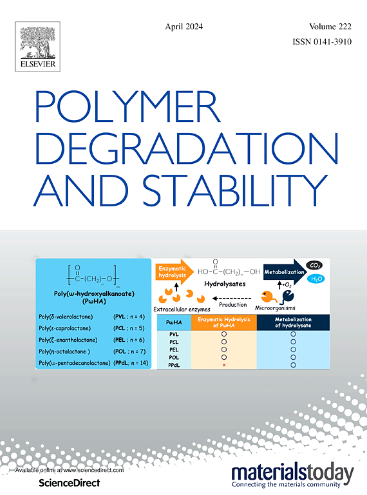用于自膨胀支架的高取向聚(L-乳酸)单丝在使用寿命期间的失效信号:消失的无定形连接
IF 6.3
2区 化学
Q1 POLYMER SCIENCE
引用次数: 0
摘要
治疗外周动脉疾病的生物可吸收自扩张支架过早失效可能导致血栓形成,威胁患者生命。预测机械和结构失效的时间和原因对于防止植入支架过早失效至关重要。在此,我们报告了一种原位加速水解方法,以研究由高性能聚乳酸(PLLA)单丝编织的自扩张支架在正式长期加速条件下的降解特性。对降解、微观结构和机械性能进行了全面评估,以确定寿命期内失效的关键因素。结果表明,加速水解的温度上限为 50 °C。机械性能经历了功能保持、下降和最终失效等多个阶段。这归因于结晶和非晶区域的不均匀降解和分布。具体来说,纤维之间的无定形链在 6 个月后消失,导致机械性能失效。在 18 个月时,纤维内部的无定形链进一步消失,导致结构解体。此外,还验证了支架的降解行为以及降解产物对血管组织的潜在影响,以确保预测的准确性。这些见解为优化基于聚乳酸的自膨胀支架的设计和临床应用提供了宝贵的实验参考。本文章由计算机程序翻译,如有差异,请以英文原文为准。
Failure signal of high orientation Poly(L-lactic acid) monofilament for self-expanding stent during lifetime: Disappeared amorphous connections
The premature failure of bioresorbable self-expanding stents for peripheral arterial disease could lead to form thrombosis and threaten patients′ lives. Predicting the time and cause of mechanical and structural failure is crucial to prevent premature failure of implanted stents. Herein, we report a situ accelerated hydrolysis to investigate the degradation properties of self-expanding stents braided by high-performance Poly(L-lactic acid) (PLLA) monofilaments in an accelerated term over a formal long one. Degradation, microstructure, and mechanical properties were comprehensively evaluated to identify key factors of the failure during lifetime. The results show that the upper temperature limit for accelerated hydrolysis is 50 °C. The mechanical properties undergo multiple stages of functional holding, decreasing, and eventual failure. It is attributed to uneven degradation and distribution of crystalline and amorphous regions. Specifically, the disappearance of amorphous chains between fibrils at 6 months leads to mechanical failure. Further disappearance of amorphous chains within fibrils at 18 months results in structural disintegration. Additionally, the degradation behavior of the stents and potential effects of degradation products on vascular tissues are validated for predictive accuracy. These insights provide valuable experimental references for optimizing design and clinical application of PLLA-based self-expanding stents.
求助全文
通过发布文献求助,成功后即可免费获取论文全文。
去求助
来源期刊

Polymer Degradation and Stability
化学-高分子科学
CiteScore
10.10
自引率
10.20%
发文量
325
审稿时长
23 days
期刊介绍:
Polymer Degradation and Stability deals with the degradation reactions and their control which are a major preoccupation of practitioners of the many and diverse aspects of modern polymer technology.
Deteriorative reactions occur during processing, when polymers are subjected to heat, oxygen and mechanical stress, and during the useful life of the materials when oxygen and sunlight are the most important degradative agencies. In more specialised applications, degradation may be induced by high energy radiation, ozone, atmospheric pollutants, mechanical stress, biological action, hydrolysis and many other influences. The mechanisms of these reactions and stabilisation processes must be understood if the technology and application of polymers are to continue to advance. The reporting of investigations of this kind is therefore a major function of this journal.
However there are also new developments in polymer technology in which degradation processes find positive applications. For example, photodegradable plastics are now available, the recycling of polymeric products will become increasingly important, degradation and combustion studies are involved in the definition of the fire hazards which are associated with polymeric materials and the microelectronics industry is vitally dependent upon polymer degradation in the manufacture of its circuitry. Polymer properties may also be improved by processes like curing and grafting, the chemistry of which can be closely related to that which causes physical deterioration in other circumstances.
 求助内容:
求助内容: 应助结果提醒方式:
应助结果提醒方式:


